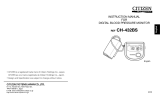
- Eng 4 -
Deutsch
English Español Português Italiano Français
- Eng 5 -
English
EspañolPortuguêsDeutsch
Français Italiano
GENERAL REMARKS
8. Measure your blood pressure when you are relaxed and still. Keep the center of
the cuff at the level of your heart and DO NOT move your arm or talk.
9. DO NOT measure blood pressure when the cuff has been on your arm for a few
minutes or more. During this time, your arm will have built up a higher blood
pressure and you will not get valid reading.
10. If the Body Movement Indicator or Irregular Heartbeat (IHB) Indicator is
displayed, relax and measure your blood pressure again. If the Irregular
Heartbeat (IHB) Indicator appears frequently, you are advised to consult a
doctor about your health condition. ( See page 15)
11.
The fi gure below shows the blood pressure classifi cations under the WHO standards.
Precautions for use
1. If you suffer from heart disease, high blood pressure or other circulatory disease,
consult your physician before using the monitor.
2. If the cuff pressure feels abnormal or you experience any other irregularity while
using the cuff, reduce the pressure immediately by pressing the “START/STOP”
switch, detach the cuff or unplug the air hose connector from the monitor and
then consult the sales outlet where you purchased the monitor.
3. If you think the measurement is abnormal or if measurement makes you feel
unwell, discontinue use and consult your physician.
4. Blood pressure measurement may not be possible for anyone with a weak pulse
or arrhythmia.
5. Repeated blood pressure measurement may cause problems such as
congestion or swelling in some people.
6. Frequently repeated blood pressure measurements will not give accurate
results. Allow an interval of about 1 minute between measurements.
7. If you suffer from a severe problem with blood circulation in your arms, consult
your physician before using the monitor. Failure to do so could be hazardous to
your health.
8. Measurement may not be possible for anyone with insuffi cient blood fl ow to the
area where measurements will be taken or who suffers from a frequent irregular
heartbeat. Consult your physician for advice on whether to use the monitor.
9. DO NOT wrap the cuff around an injured arm.
10. DO NOT wrap the cuff around an arm in which a drip (intravenous infusion)
is inserted, or which is being used for blood transfusion as part of medical
treatment. Doing so could result in an injury or a serious accident.
11. DO NOT use the monitor in the vicinity of fl ammable gases such as those used
for anaesthesia. Doing so could ignite the gases and cause an explosion.
12. DO NOT use the monitor in enriched oxygen environments such as a hospital’s
hyperbaric chamber or oxygen tent. Doing so could ignite the oxygen and
cause a fi re.
13. DO NOT use mobile phones near the monitor as this could result in a
malfunction.
14. If you use a cardiac pacemaker, consult your physician before using the monitor.
15. Be sure to use this unit only for measuring blood pressure. DO NOT use it for
any other purpose.
16. Be sure to use only our authorized parts and accessories. Parts and
accessories not approved for use with the device may damage the unit.
PRECAUTIONS FOR USE AND MAINTENANCE
12. Intended Use
• This device is noninvasive blood pressure monitor by oscillometric method.
This device can measure the systolic blood pressure (SYS), the diastolic blood
pressure (DIA) and the pulse rate automatically.
•
This device is intended to be used for checking personal health condition at home
under the direction of a physician and is not intended to be a diagnostic device.
• This device is not intended for use with neonates or infant, and not intended
for automatic cycling measurement.
Measure your blood pressure at the same time each day.
*
Your blood pressure changes all the time. This means that data gathered over a
long period has far more signifi cance than data from just one measurement. For this
reason, you must measure your blood pressure on a daily basis. Ideally, you should
measure your blood pressure at the same time each day, wherever possible.
Remarks:
The graph is not exact, but
may be used as a guide in
understanding non-invasive
blood pressure measurements.
The device is only intended for
use by adults.
Defi nitions and Classifi cations of Blood Pressure Levels
SYSTOLIC
(mmHg)
180
160
140
130
120
80 85 90 100 110 DIASTOLIC
(mmHg)
Grade 3 Hypertension (severe)
Grade 2 Hypertension (moderate)
Grade 1 Hypertension (mild)
High-Normal
Normal
Optimal























